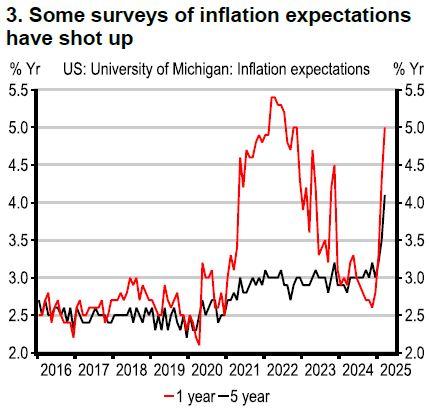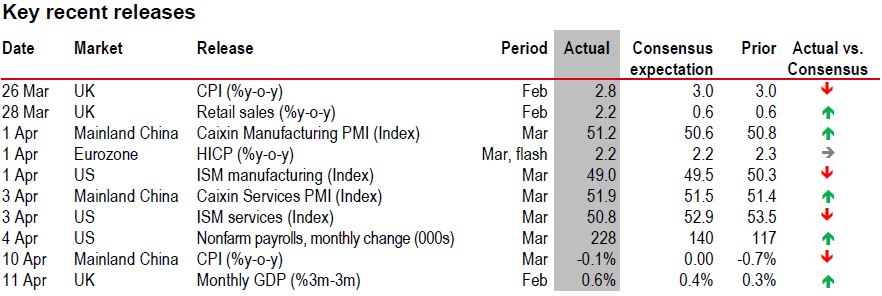
22 April 2025
The pace of US policy shifts since the ‘Liberation Day’ announcements has been dramatic. The reciprocal tariffs, related financial market turmoil, the US’s rapid Uturn, and a doubling down on mainland China tariffs will undoubtedly weigh on trade flows, investment plans, and broader activity. And for many economies the impact is likely to be substantial.
The tariff turmoil is bad news for the global economy but there will still be relative winners and losers. Countries with lower exposure to US imports of tariffed items, particularly if also set to benefit from China and EU fiscal stimulus, will be more immune, and vice versa. Others could gain by supplying goods currently sourced from China, if US trade actions make them prohibitively expensive. Vietnam, Mexico, Thailand, and India are top of that list, if they can avoid large tariffs themselves. Meanwhile, economies like Brazil could benefit if China sources more agricultural products from outside the US.

Note: Mexico and Canada are exempt from the baseline 10% tariff.
Source: IMF DOTS
The biggest uncertainty effects may be in the US itself. At a minimum, there will be enormous disruptions to supply chains for a vast array of small and large US companies. The tariffs might slow imports and push up prices for companies and consumers. US profit margins are likely to be squeezed. And companies reliant on foreign components could be less competitive in international markets and consumer goods prices will rise.
As well as overall dependence, product mix of trade flows will also determine the direct impact. Some products are exempt from the 10% baseline reciprocal tariffs – either because they fit into the categories of energy and critical minerals, or because the US can’t easily source them domestically – for example zinc, tin, and other base metals. Products that face higher tariffs include autos, steel, and aluminium (already in place), and, potentially, pharmaceuticals and semiconductors.
The main area of bilateral trade with the US that looks set to plummet is between the US and China. However, the world’s two largest economies are less reliant on each other than in the past: just over 13% of US imports are from mainland China and less than 15% of mainland China’s exports go to the US. On the other side of the relationship, only c7% of US exports go to mainland China and only c6% of mainland China’s imports are from the US (Chart 2).
The path for inflation is uncertain, but tariffs are likely to mean US goods prices are higher, even if much of the tariff impact weighs more on US growth. That risk is clearly being reflected in consumer surveys, with inflation expectations rising (Chart 3). Elsewhere, weaker growth, lower oil and gas prices, and recent currency appreciation point to lower inflation. Trade diversion may also mean a near-term disinflationary impulse as goods intended for the US market are re-routed: just how much depends on how many more trade actions are taken by other countries vis-a-vis China.

Source: Macrobond

Source: Macrobond
We recently lowered our global GDP growth forecasts to 2.3% (from 2.5%) for 2025 and to 2.3% (from 2.7%) for 2026. Our forecasts for nearly every economy have been lowered, even Canada and Mexico, which were not hit by additional tariffs in April, in response to the deteriorating outlook for US growth.
There has been a more diverse impact on our inflation and monetary policy forecasts. Although we have lowered our US growth forecast materially to 1% 4Q/4Q in 2025, the deteriorating growth-inflation trade-off means we have not changed our long-held Federal Funds view of no more than 75bp of rate cuts in 2025-26.
We expect stronger policy responses elsewhere, including more from the European Central Bank and many emerging economies, even though we are not expecting aggressive rate cuts. It is not just monetary policy that could soften the blow from trade uncertainty, which is already spurring fiscal, deregulatory, and structural measures from Europe to Asia.

Note: *India data is calendar year forecast here for comparability. Previous forecasts are shown in parenthesis and are from the Macro Monthly dated 20 December 2024.
Green indicates an upward revision, red indicates a downward revision.
Source: Bloomberg, HSBC Economics

Source: Bloomberg, HSBC
⬆Positive surprise – actual is higher than consensus, ⬇ Negative surprise – actual is lower than consensus, ➡ Actual is in line with consensus

Source: LSEG Eikon, HSBC






Additional disclosures
1. This report is dated as at 17 April 2025.
2. All market data included in this report are dated as at close 16 April 2025, unless a different date and/or a specific time of day is indicated in the report.
3. HSBC has procedures in place to identify and manage any potential conflicts of interest that arise in connection with its Research business. HSBC's analysts and its other staff who are involved in the preparation and dissemination of Research operate and have a management reporting line independent of HSBC's Investment Banking business.Information Barrier procedures are in place between the Investment Banking, Principal Trading, and Research businesses to ensure that any confidential and/or price sensitive information is handled in an appropriate manner.
4. You are not permitted to use, for reference, any data in this document for the purpose of (i) determining the interest payable, or other sums due, under loan agreements or under other financial contracts or instruments, (ii) determining the price at which a financial instrument may be bought or sold or traded or redeemed, or the value of a financial instrument, and/or (iii) measuring the performance of a financial instrument or of an investment fund.
This document is prepared by The Hongkong and Shanghai Banking Corporation Limited (‘HBAP’), 1 Queen’s Road Central, Hong Kong. HBAP is incorporated in Hong Kong and is part of the HSBC Group. This document is distributed by HSBC Continental Europe, HBAP, HSBC Bank (Singapore) Limited, HSBC Bank (Taiwan) Limited, HSBC Bank Malaysia Berhad (198401015221 (127776-V))/HSBC Amanah Malaysia Berhad (200801006421 (807705-X)), The Hongkong and Shanghai Banking Corporation Limited, India (HSBC India), HSBC Bank Middle East Limited, HSBC UK Bank plc, HSBC Bank plc, Jersey Branch, and HSBC Bank plc, Guernsey Branch, HSBC Private Bank (Suisse) SA, HSBC Private Bank (Suisse) SA DIFC Branch, HSBC Private Bank Suisse SA, South Africa Representative Office, HSBC Financial Services (Lebanon) SAL, HSBC Private banking (Luxembourg) SA and The Hongkong and Shanghai Banking Corporation Limited (collectively, the “Distributors”) to their respective clients. This document is for general circulation and information purposes only. This document is not prepared with any particular customers or purposes in mind and does not take into account any investment objectives, financial situation or personal circumstances or needs of any particular customer. HBAP has prepared this document based on publicly available information at the time of preparation from sources it believes to be reliable but it has not independently verified such information. The contents of this document are subject to change without notice. HBAP and the Distributors are not responsible for any loss, damage or other consequences of any kind that you may incur or suffer as a result of, arising from or relating to your use of or reliance on this document. HBAP and the Distributors give no guarantee, representation or warranty as to the accuracy, timeliness or completeness of this document. This document is not investment advice or recommendation nor is it intended to sell investments or services or solicit purchases or subscriptions for them. You should not use or rely on this document in making any investment decision. HBAP and the Distributors are not responsible for such use or reliance by you. You should consult your professional advisor in your jurisdiction if you have any questions regarding the contents of this document. You should not reproduce or further distribute the contents of this document to any person or entity, whether in whole or in part, for any purpose. This document may not be distributed to any jurisdiction where its distribution is unlawful.
The following statement is only applicable to HSBC Bank (Taiwan) Limited with regard to how the publication is distributed to its customers: HSBC Bank (Taiwan) Limited (“the Bank”) shall fulfill the fiduciary duty act as a reasonable person once in exercising offering/conducting ordinary care in offering trust services/business. However, the Bank disclaims any guaranty on the management or operation performance of the trust business.
The following statement is only applicable to by HSBC Bank Australia with regard to how the publication is distributed to its customers: This document is distributed by HSBC Bank Australia Limited ABN 48 006 434 162, AFSL/ACL 232595 (HBAU). HBAP has a Sydney Branch ARBN 117 925 970 AFSL 301737.The statements contained in this document are general in nature and do not constitute investment research or a recommendation, or a statement of opinion (financial product advice) to buy or sell investments. This document has not taken into account your personal objectives, financial situation and needs. Because of that, before acting on the document you should consider its appropriateness to you, with regard to your objectives, financial situation, and needs.
Important Information about the Hongkong and Shanghai Banking Corporation Limited, India (“HSBC India”)
HSBC India is a branch of The Hongkong and Shanghai Banking Corporation Limited. HSBC India is a distributor of mutual funds and referrer of investment products from third party entities registered and regulated in India. HSBC India does not distribute investment products to those persons who are either the citizens or residents of United States of America (USA), Canada or New Zealand or any other jurisdiction where such distribution would be contrary to law or regulation.
Mainland China
In mainland China, this document is distributed by HSBC Bank (China) Company Limited (“HBCN”) and HSBC FinTech Services (Shanghai) Company Limited to its customers for general reference only. This document is not, and is not intended to be, for the purpose of providing securities and futures investment advisory services or financial information services, or promoting or selling any wealth management product. This document provides all content and information solely on an "as-is/as-available" basis. You SHOULD consult your own professional adviser if you have any questions regarding this document.
The material contained in this document is for general information purposes only and does not constitute investment research or advice or a recommendation to buy or sell investments. Some of the statements contained in this document may be considered forward looking statements which provide current expectations or forecasts of future events. Such forward looking statements are not guarantees of future performance or events and involve risks and uncertainties. Actual results may differ materially from those described in such forward-looking statements as a result of various factors. HSBC India does not undertake any obligation to update the forward-looking statements contained herein, or to update the reasons why actual results could differ from those projected in the forward-looking statements. Investments are subject to market risk, read all investment related documents carefully.
© Copyright 2025. The Hongkong and Shanghai Banking Corporation Limited, ALL RIGHTS RESERVED.
No part of this document may be reproduced, stored in a retrieval system, or transmitted, on any form or by any means, electronic, mechanical, photocopying, recording or otherwise, without the prior written permission of The Hongkong and Shanghai Banking Corporation Limited.
Important information on sustainable investing
“Sustainable investments” include investment approaches or instruments which consider environmental, social, governance and/o r other sustainability factors (collectively, “sustainability”) to varying degrees. Certain instruments we include within this category may be in the process of changing to deliver sustainability outcomes.
There is no guarantee that sustainable investments will produce returns similar to those which don’t consider these factors. Sustainable investments may diverge from traditional market benchmarks.
In addition, there is no standard definition of, or measurement criteria for sustainable investments, or the impact of sustainable investments (“sustainability impact”). Sustainable investment and sustainability impact measurement criteria are (a) highly subjective and (b) may vary significantly across and within sectors.
HSBC may rely on measurement criteria devised and/or reported by third party providers or issuers. HSBC does not always conduct its own specific due diligence in relation to measurement criteria. There is no guarantee: (a) that the nature of the sustainability impact or measurement criteria of an investment will be aligned with any particular investor’s sustainability goals; or (b) that the stated level or target level of sustainability impact will be achieved.
Sustainable investing is an evolving area and new regulations may come into effect which may affect how an investment is categorised or labelled. An investment which is considered to fulfil sustainable criteria today may not meet those criteria at some point in the future.